Text and Photos by Christine Anne
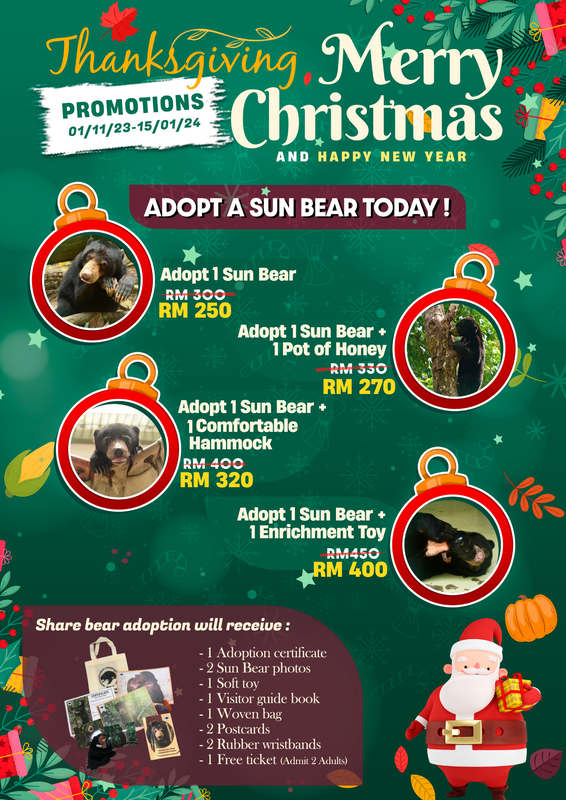
My name is Christine Anne and I am a Lead Zoo Keeper at Woodland Park Zoo (WPZ), Seattle, Washington, USA. I have worked at WPZ for three years but have been a zoo keeper for 14 years. At WPZ I work with a variety of species but I specialize in large carnivores and work with African lions, Malayan tigers, and sloth bears to name a few. I have worked with bears for many years and first met Wong, founder of the Bornean Sun Bear Conservation Center (BSBCC), in 2009 when he presented his research on sun bears at the Advancing Bear Care Conference in San Francisco, California. I had the opportunity again to hear Wong speak at the Advancing Bear Care Conference in Banff Canada in 2011, where he spoke about BSBCC and its progress and future. Since first hearing of BSBCC it has been a personal and professional goal of mine travel to Borneo and volunteer.
Through my work with the Malayan tigers at WPZ, the zoo supported me in an opportunity to accompany other zoo keepers from North America to peninsular Malaysia. We visited the Taman Negara to participate in a citizen conservation program called the Malaysian Conservation Alliance for Tigers. We participated in anti-poaching patrols and experience the forest that presents so many challenges to tiger researchers. Through the support of the Puget Sound Chapter of the American Association of Zoo Keepers, I was able to include BSBCC in my travel plans.
Upon first arriving at BSBCC I was warmly welcomed by Wong and his staff. One of the first things I noticed about the conservation center was the amazing signage that they use to help educate visitors about sun bears. These signs are placed along the path that leads to the viewing platforms for the forest enclosures where the bears live. These platforms give a great opportunity for guests to see the bears in their natural forest habitat. As a zoo keeper I notice things that a regular guest may not notice. Things like the nice high railings on the platforms to keep guests from leaning over the enclosures, the perimeter of the enclosures and how they are situated around the holding facilities, how the staff gains access for feeding and checking fences, and the many natural behaviors being displayed by the bears.
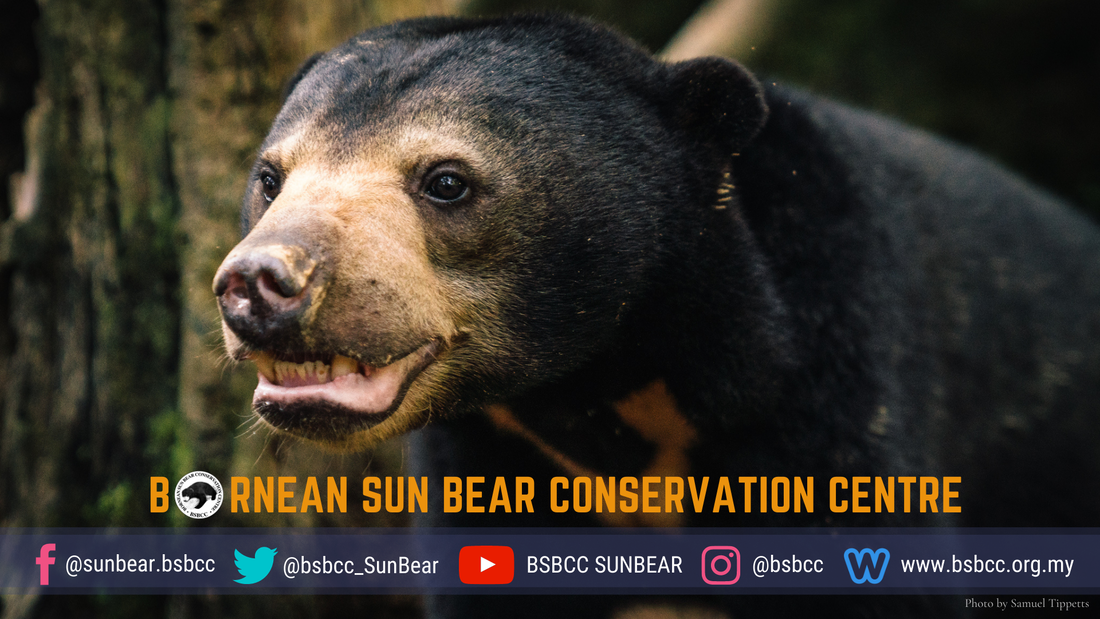
Volunteering
The volunteer orientation was very familiar, since the same rules apply in my daily job. Things like don’t enter an area that has a bear in it, don’t touch the bears, don’t do anything that makes you uncomfortable or you are unsure of. Working with animals like bears is a serious business no matter what side of the world you are on. Although I am a zoo keeper, I also understand that this is not WPZ, these bears are not my normal charges, and it is a privilege to simply be in the presence of these amazing animals that deserve our respect and care. Care of an animal has many forms, from cleaning holding dens, to grounds work, to the office, and guest services. As a volunteer I had two assignments: the bear kitchen, and enrichment making.
The volunteer orientation was very familiar, since the same rules apply in my daily job. Things like don’t enter an area that has a bear in it, don’t touch the bears, don’t do anything that makes you uncomfortable or you are unsure of. Working with animals like bears is a serious business no matter what side of the world you are on. Although I am a zoo keeper, I also understand that this is not WPZ, these bears are not my normal charges, and it is a privilege to simply be in the presence of these amazing animals that deserve our respect and care. Care of an animal has many forms, from cleaning holding dens, to grounds work, to the office, and guest services. As a volunteer I had two assignments: the bear kitchen, and enrichment making.
Kitchen
The kitchen is the lifeline of the whole animal care program, preparing food that provides the very nutrition that all 41 bears at BSBCC rely on for survival. Through food preparation I can honestly say that I touched every bear at BSBCC through their food. It is constant work in the kitchen preparing food for the 4 meals each bear gets each day. For 41 bears, that’s 164 meals prepared, each day. The base diet is rice porridge, with each bear getting an individualized amount in the morning and again in the evening. When you are done portioning out porridge, you make a new batch, there is constantly something cooking in the kitchen, with two large pots of porridge made everyday. For the other feedings, the bears get keepers choice of fruits and vegetables, with bananas a main staple every day. I learned of a new fruit called snake skin fruit. The skin of this fruit really does look like snake skin, and when peeled it has cloves inside similar to garlic but it has the texture of an apple and, to me, tasted almost like mild pineapple.
The kitchen is the lifeline of the whole animal care program, preparing food that provides the very nutrition that all 41 bears at BSBCC rely on for survival. Through food preparation I can honestly say that I touched every bear at BSBCC through their food. It is constant work in the kitchen preparing food for the 4 meals each bear gets each day. For 41 bears, that’s 164 meals prepared, each day. The base diet is rice porridge, with each bear getting an individualized amount in the morning and again in the evening. When you are done portioning out porridge, you make a new batch, there is constantly something cooking in the kitchen, with two large pots of porridge made everyday. For the other feedings, the bears get keepers choice of fruits and vegetables, with bananas a main staple every day. I learned of a new fruit called snake skin fruit. The skin of this fruit really does look like snake skin, and when peeled it has cloves inside similar to garlic but it has the texture of an apple and, to me, tasted almost like mild pineapple.
When we were not preparing food, we were cleaning the kitchen and doing dishes. I had looked forward to the whole experience for so many years that I was so happy to do something so simple, yet so helpful to the overall operations. I also had the opportunity to feed some of the bears, either sliding the porridge to them in the bear holding areas, or helping with the scatter feeds for the outdoor forest enclosures. Both experiences allowed me to see the bears up close and observe more of their behaviors. I am very interested in animal behavior, so opportunities to observe behavior are always special.
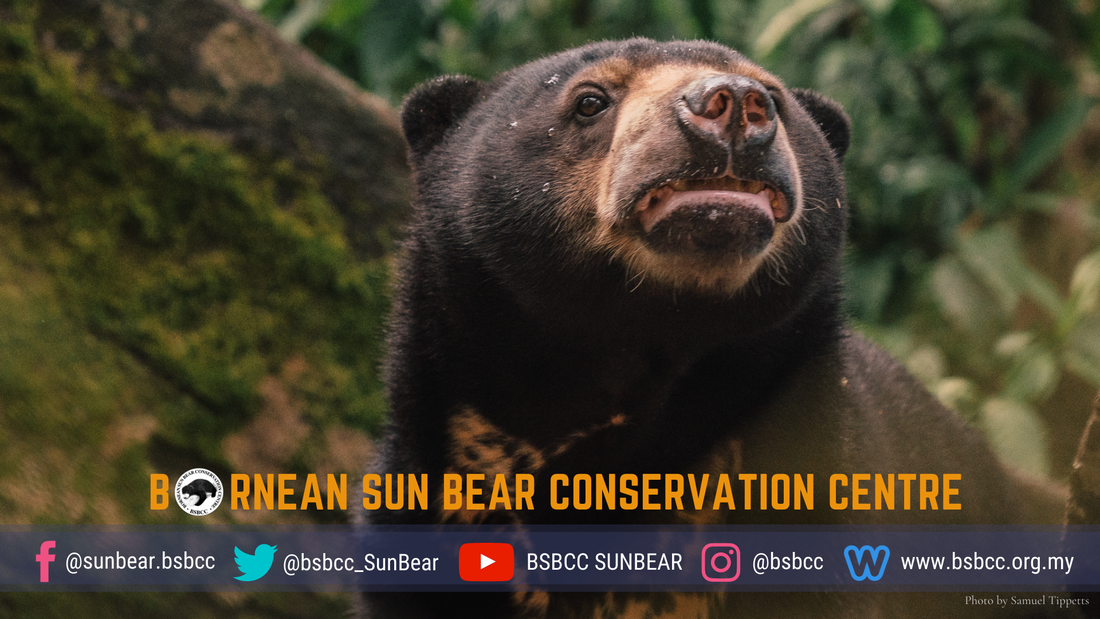
Enrichment
I was also assigned to help make enrichment for the bears with the keepers. We mainly focused on bamboo enrichment and we went out to collect the bamboo, and worked on cutting it up and building different enrichment items for the bears to receive inside the holding areas. Bamboo is great because it can be made into all kinds of things, but sun bears are very destructive so we had to balance complexity of the enrichment item with the value to the animal. We made a variety of puzzle feeders and used different enrichment food items inside like peanut butter and honey. We used leaves from forage plants to fill the feeders as well. I was able to observe the bears with the enrichment items that gave the bears opportunities to problem solve and manipulate the items. One bear in particular received one of the more challenging items and spent about 10 minutes investigating it, ripping it apart and eating the peanut butter off of the ginger leaves and out from the bamboo. He was very vocal the whole time he was interacting with the item, which may indicate that he was slightly irritated at the complexity of it, but he took the time to fully destroy the whole thing and enjoy all that it had to offer. It is always nice to watch the animals interact with something that you have made for them.
I was also assigned to help make enrichment for the bears with the keepers. We mainly focused on bamboo enrichment and we went out to collect the bamboo, and worked on cutting it up and building different enrichment items for the bears to receive inside the holding areas. Bamboo is great because it can be made into all kinds of things, but sun bears are very destructive so we had to balance complexity of the enrichment item with the value to the animal. We made a variety of puzzle feeders and used different enrichment food items inside like peanut butter and honey. We used leaves from forage plants to fill the feeders as well. I was able to observe the bears with the enrichment items that gave the bears opportunities to problem solve and manipulate the items. One bear in particular received one of the more challenging items and spent about 10 minutes investigating it, ripping it apart and eating the peanut butter off of the ginger leaves and out from the bamboo. He was very vocal the whole time he was interacting with the item, which may indicate that he was slightly irritated at the complexity of it, but he took the time to fully destroy the whole thing and enjoy all that it had to offer. It is always nice to watch the animals interact with something that you have made for them.
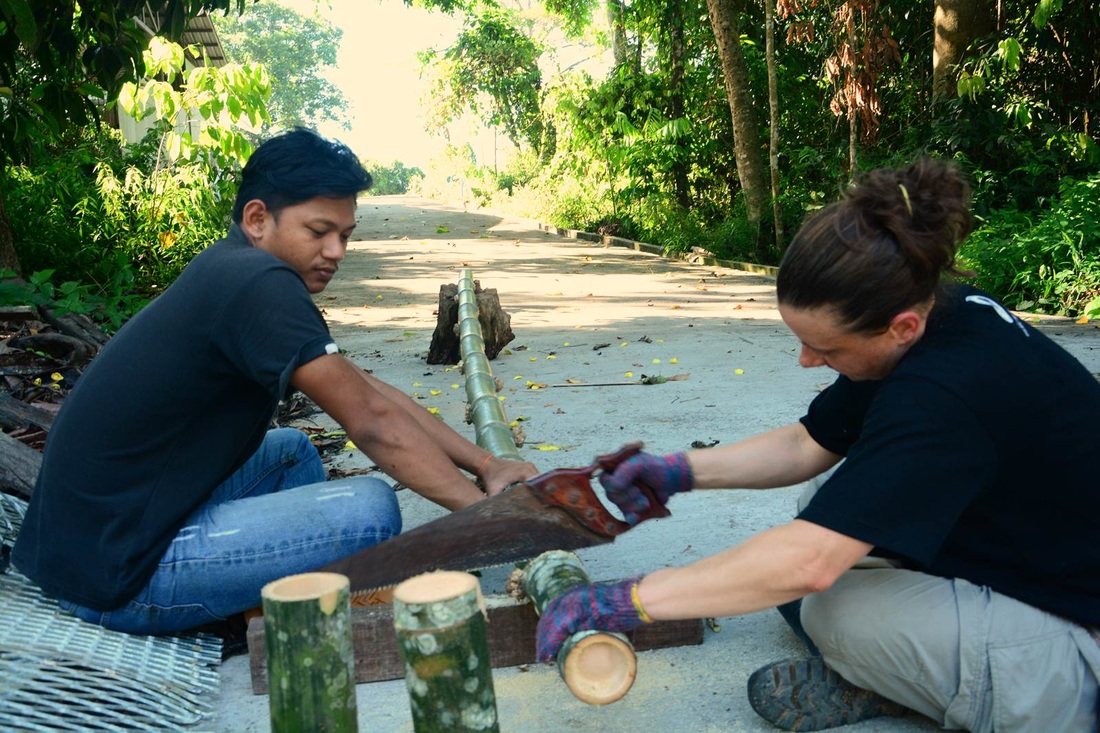
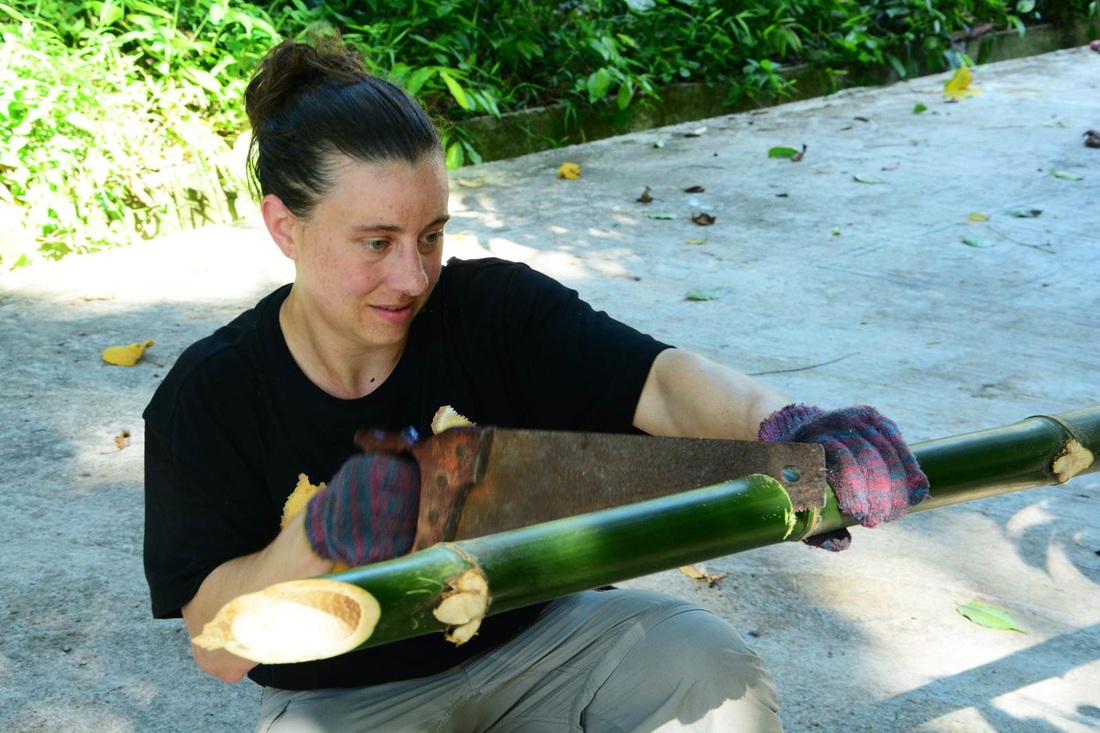
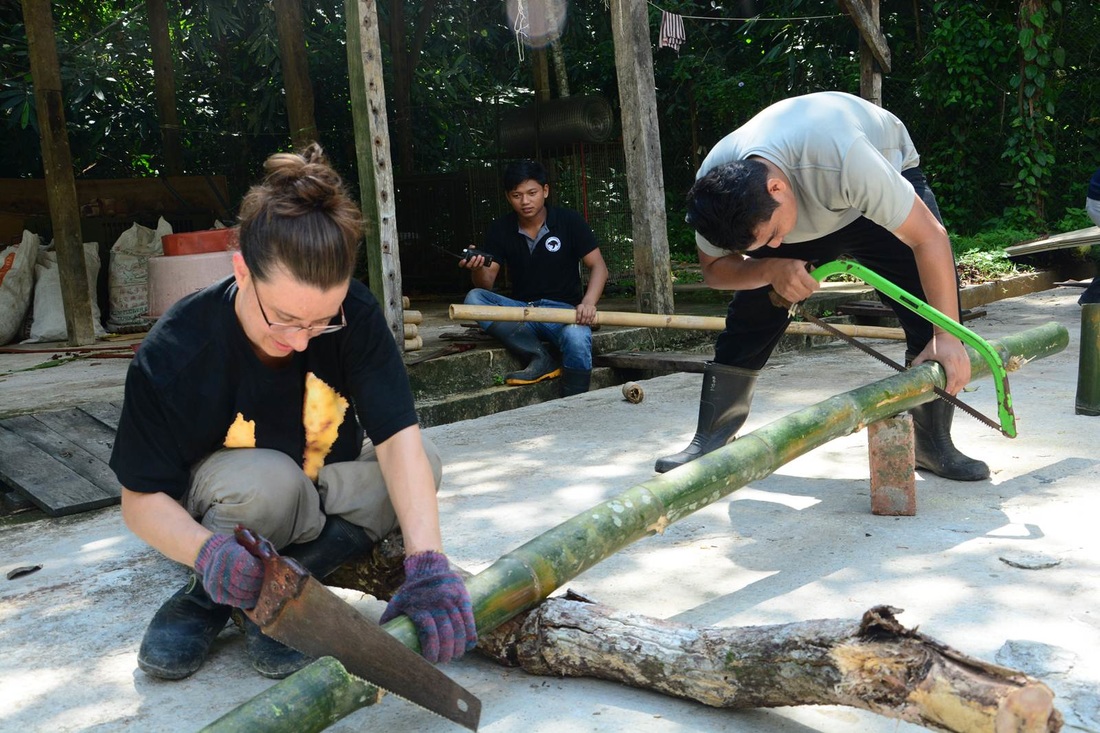
The opportunity to be part of the BSBCC program and contribute in whatever way I was needed was motivating and inspiring. Wong’s enthusiasm for his work and the development of a word class conservation center is obvious and contagious, and is the driving force behind its continued success and future development. It was an AMAZING experience with amazing staff and animals, one that forever stamps a sun bear paw print on my heart as I journey on.
No comments:
Post a Comment